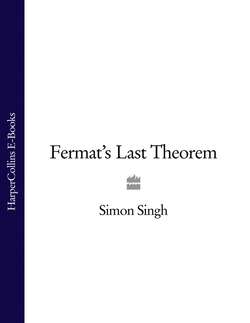Читать книгу Fermat’s Last Theorem - Simon Singh, Simon Singh - Страница 7
Preface
ОглавлениеThe story of Fermat’s Last Theorem is inextricably linked with the history of mathematics, touching on all the major themes of number theory. It provides a unique insight into what drives mathematics and, perhaps more importantly, what inspires mathematicians. The Last Theorem is at the heart of an intriguing saga of courage, skulduggery, cunning and tragedy, involving all the greatest heroes of mathematics.
Fermat’s Last Theorem has its origins in the mathematics of ancient Greece, two thousand years before Pierre de Fermat constructed the problem in the form we know it today. Hence, it links the foundations of mathematics created by Pythagoras to the most sophisticated ideas in modern mathematics. In writing this book I have chosen a largely chronological structure which begins by describing the revolutionary ethos of the Pythagorean Brotherhood, and ends with Andrew Wiles’s personal story of his struggle to find a solution to Fermat’s conundrum.
Chapter 1 tells the story of Pythagoras, and describes how Pythagoras’ theorem is the direct ancestor of the Last Theorem. This chapter also discusses some of the fundamental concepts of mathematics which will recur throughout the book. Chapter 2 takes the story from ancient Greece to seventeenth-century France, where Pierre de Fermat created the most profound riddle in the history of mathematics. To convey the extraordinary character of Fermat and his contribution to mathematics, which goes far beyond the Last Theorem, I have spent several pages describing his life, and some of his other brilliant discoveries.
Chapters 3 and 4 describe some of the attempts to prove Fermat’s Last Theorem during the eighteenth, nineteenth and early twentieth centuries. Although these efforts ended in failure they led to a marvellous arsenal of mathematical techniques and tools, some of which have been integral to the very latest attempts to prove the Last Theorem. In addition to describing the mathematics I have devoted much of these chapters to the mathematicians who became obsessed by Fermat’s legacy. Their stories show how mathematicians were prepared to sacrifice everything in the search for truth, and how mathematics has evolved through the centuries.
The remaining chapters of the book chronicle the remarkable events of the last forty years which have revolutionised the study of Fermat’s Last Theorem. In particular Chapters 6 and 7 focus on the work of Andrew Wiles, whose breakthroughs in the last decade astonished the mathematical community. These later chapters are based on extensive interviews with Wiles. This was a unique opportunity for me to hear at first hand one of the most extraordinary intellectual journeys of the twentieth century and I hope that I have been able to convey the creativity and heroism that was required during Wiles’s ten-year ordeal.
In telling the tale of Pierre de Fermat and his baffling riddle I have tried to describe the mathematical concepts without resorting to equations, but inevitably x, y and z do occasionally rear their ugly heads. When equations do appear in the text I have endeavoured to provide sufficient explanation such that even readers with no background in mathematics will be able to understand their significance. For those readers with a slightly deeper knowledge of the subject I have provided a series of appendices which expand on the mathematical ideas contained in the main text. In addition I have included a list of further reading, which is generally aimed at providing the layperson with more detail about particular areas of mathematics.
This book would not have been possible without the help and involvement of many people. In particular I would like to thank Andrew Wiles, who went out of his way to give long and detailed interviews during a time of intense pressure. During my seven years as a science journalist I have never met anybody with a greater level of passion and commitment to their subject, and I am eternally grateful that Professor Wiles was prepared to share his story with me.
I would also like to thank the other mathematicians who helped me in the writing of this book and who allowed me to interview them at length. Some of them have been deeply involved in tackling Fermat’s Last Theorem, while others were witnesses to the historic events of the last forty years. The hours I spent quizzing and chatting with them were enormously enjoyable and I appreciate their patience and enthusiasm while explaining so many beautiful mathematical concepts to me. In particular I would like to thank John Coates, John Conway, Nick Katz, Barry Mazur, Ken Ribet, Peter Sarnak, Goro Shimura and Richard Taylor.
I have tried to illustrate this book with as many portraits as possible to give the reader a better sense of the characters involved in the story of Fermat’s Last Theorem. Various libraries and archives have gone out of their way to help me, and in particular I would like to thank Susan Oakes of the London Mathematical Society, Sandra Cumming of the Royal Society and Ian Stewart of Warwick University. I am also grateful to Jacquelyn Savani of Princeton University, Duncan McAngus, Jeremy Gray, Paul Balister and the Isaac Newton Institute for their help in finding research material. Thanks also go to Patrick Walsh, Christopher Potter, Bernadette Alves, Sanjida O’Connell and my parents for their comments and support throughout the last year.
Finally, many of the interviews quoted in this book were obtained while I was working on a television documentary on the subject of Fermat’s Last Theorem. I would like to thank the BBC for allowing me to use this material, and in particular I owe a debt of gratitude to John Lynch, who worked with me on the documentary, and who helped to inspire my interest in the subject.
Simon Singh
Thakarki, Phagwara
1997
